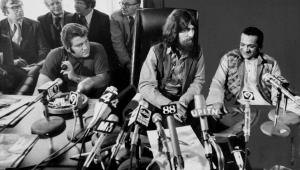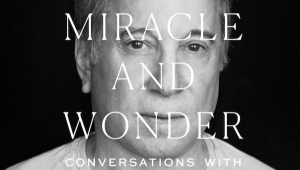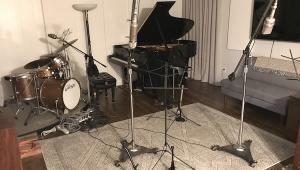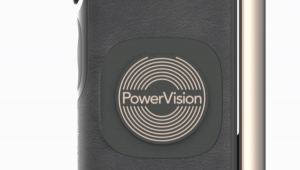The Doors and The Elektra Records Sound Part 2
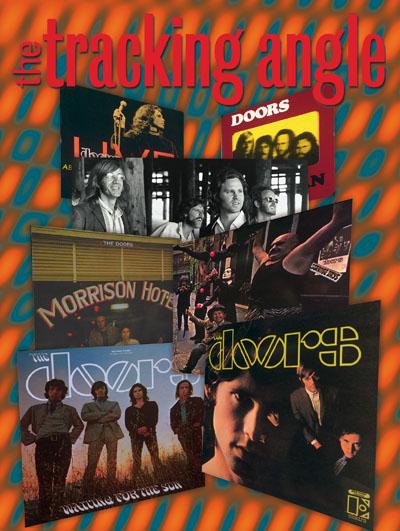
MG: Jumping back into some old groups that you recorded, Brazil 66....
BB: I really loved that time. That was for Herb Alpert, who was the producer. I prefer Brazil 66, the first album, over Equinox, sonically, because that was another case where it was done on four-track, tube all the way. Also the fact that it was all new to us and it was a big sound, I really liked it.
MG: Was that done at Gold Star Studios?
BB: No, I never had the good fortune to record at Gold Star; they were both done at Sunset Sound. Equinox was eight-track. It's a funny thing, I remember when I was doing Earth, Wind & Fire, and we had one of the first 24-tracks. I remember going out to the band and saying, "We've got 24 tracks, let's not use all of the 24 of the tracks if we don't have to.” What's happened with the advent of multi-track technology is that it's given us too much of an opportunity to push off decisions until later on, and so indecision is now the rule of the day.
MG: Let's move on to the new Doors box set. On some of the tracks, like the 1965 demos, you put them through Sonic Solutions™. Can you describe what that does, and how it improves the sound?
BB: Well, basically, the only noise that was on there was surface noise from an acetate that Ray Manzarek has. Using the Sonic Solutions™ in the “de-crackling” mode, we were able to take out all of the clicks and pops. We didn't use the NoNoise™ process to reduce tape hiss; there was no need to do any of that.
MG: There's a couple of songs that you guys did some overdubs on, "Whisky, Mystics and Men" and "Orange County Suite"; tell me about those.
BB: We did all the overdubs at Ocean Way Studios. We did some of them in Studio B, and the majority of them in Studio One, which was the same one that I did Forever Changes in, and the same room where Sinatra recorded "Strangers In The Night" and Barbara Streisand did "The Way We Were." The muse is very strong there.
MG: "Orange County Suite" is very interesting. On the basic track, Jim was playing piano and singing, and I would say that it's fair to assume that he didn't have the greatest sense of time. Did you have to do anything to compensate for that?
BB: (laughs) Well, I played some games, in order for them to be able to play along (with the track)....
MG: A magician doesn't want to give away his secrets.
BB: Right...(laughter). We electronically manipulated it so that the guys could play along.
MG: Fair enough. What processing or remixing did you do on some of the lower-quality live material, like the tapes from the Matrix?
BB: Well, there was no remixing. Those were bootleg recordings. Basically what I did with those is NoNoise™ them (using a series of digital filters), with the Sonic™. Also, do you understand what azimuth is on an analog machine?
MG: Not exactly.
BB: What azimuth is, if you hear a tape that hasn't been azimuthed correctly, and you switch it to mono, you can almost hear, like, phasing. What that it is, is the head's not perfectly in alignment, so if the head is out of azimuth there's a delay between channels. The tape (machines) that they used to make this bootleg were out of azimuth. When played back on the same machine the tape will play back the same way it was recorded. But play it back on another machine with different alignment, the azimuth will be out. So I was able to take one of the channels, say the right channel, and just move it by digital samples, and put the azimuth back in line, and it made a big difference in the imaging. So I did those things, and a little EQ-ing, and that was it. God knows what kind of microphones were used, and it could have been recorded at seven-and-a-half ips or even three-and-three-quarters ips, for that matter, even quarter-track, who knows? I'm just grateful that we have the document.
MG: Same thing for the PINE Coliseum cuts with Albert King?
BB: Same kind of situation. It might have been recorded on stage, or someone had a cassette machine and just popped it in. Same thing with Miami, the first cut; somebody in the audience. I've been asked, “How can you accept the sound quality the way it is?” I'm not listening to the sound, I'm listening to the moment. That's what's important. I want to clean it up to the point where it's clear, and you can at least hear what's going down and you get the music, 'cause that's what's speaking.
MG: Well, you certainly have to be thinking that way in order to do what you did. I mean, the Miami tape is the first thing. That's a bold maneuver. How did the programming of the box set come about?
BB: What I did was, I put it all together, and being that the Doors live in different areas spread out all over the city, I would do it and make them DATs, and they would listen and go, “You know, this is really great,” or “This isn't great.” I'd woodshed, and woodshed some more, and make another version. I think on the first disc I only made one change. The second disc, I didn't make any changes. The third disc, I think, went through three complete different versions. Different songs, different everything. That came together at the last moment. It was a hard one, because I couldn't feel the way it was supposed to go. But it had a natural flow, a life of its own. Again, it goes back to what Jac Holzman had created with his sequencing and his spacing and the emotion that you're trying to tell. It's very difficult for me to say to you, “Go listen to that cut ,that's indicative of the album.” You really need to sit down and listen to the whole album.
MG: Or at least one disc...all the way through.
BB: Yes, because it's an experience all by itself.
MG: What kind of condition was this “Live In New York” disc in? Was it from the same period as the Absolutely Live album?
BB: Same period. The only problem was the BASF tape that we were using was starting to get a little gummy. After 27 years the tapes still sound superb. I baked them, played them once, transferred them 20-bit to a digital 24-track and then mixed them down digitally, 20-bit, to my Genex Optical Disc recorder, and then 20-bit D-to-D right into the Sonic™, so the second disc is all 20-bit.
MG: You had mentioned remastering the entire catalogue, and when I was talking to Robby Krieger, he mentioned that one time you guys went into the studio and did a different mix of The Soft Parade without the strings and horns, just for fun. Those might make great bonus tracks....
BB: Well, we'll see. There's one song from it, "Who Scared You," and if you listen to that compared to The Soft Parade album, there's a great difference, sonically. The Doors were under a lot of pressure — Jim had just been arrested in Miami, there were issues going down internally within the band. Going forth into strings and horns with The Doors, going in that direction, some of it stands out to be the most dated because of that. "Who Scared You" was pretty indicative of what the rest of the album sounded like, except for "Wild Child," which to me sounded phenomenal; I loved that one. The Soft Parade album has some of the worst drum recording I ever did. Why, I don't know. The snare sounds like a paper bag, and the drums are all locked in one track, which makes it very difficult. Later on in that period I kept the bass drum separate on the eight-track. When I mixed "Who Scared You" for the box set, I played it out into Studio B's studio and brought it back with tube microphones and tube mic pre's. Between doing that and using the non-linear program on the AMS RMX-16, I was able to give it a more raw, three-dimensional landscape. That fixed one of the main things that troubled me about that album.
So if we were to go back, which brings me to another thing about the whole thing of remastering catalogs, is that I am not a fan of remixing stuff, because I am not the same person I was then. I'm not thinking the same way, I'm not eating the same way. I'm not the same age. I'm hearing things differently. As time has gone by, I'm hearing more drums than I did then. I'm hearing a more rhythm-oriented mix than we did then. I had to be careful when I was mixing Live In New York from the box set, because I did mix it with a little bit more drums, but I didn't go all the way that we would do it for "today's" market. I don't believe that anything's gained by remixing, unless the original master is destroyed.
MG: So the tapes sound good.
BB: All the master tapes from all of the albums sound great; they're in good shape. All I've got to do is get a good 96 K/24-bit document of it and get it out there and people will hear stuff that they didn't even hear off the analog disk, the vinyl disk.
MG: What else did you add to for the box?
BB: The "Adagio" we recorded in April of 1968 at TTG, but we didn't have the other guys on it. We put them on the day before we did "Orange County Suite." Robby did all his guitar work, John added his drum part, and Ray's part was the only part that was original.
MG: I wanted to talk to you a bit more about recording....
BB: Well, we still can!
MG: Great!. But before we do, I wanted to ask you about “The Doors,” the movie, because I know that you worked on it. What did you think of it?
BB: My thought is that it's probably the best film made that portrayed what it was like over here during that period, being that he (Oliver Stone) had done “Platoon” and portrayed what it was like over in Vietnam during that era. (The director Francis Ford) Coppola showed what it was like to be over there, too, although a bit skewed, for “Apocalypse Now”. But as far as capturing the mood, and what it looked like and felt like, I thought it was superb from that standpoint. Story-wise I can't be real critical about it, because to make a motion picture out of life is very difficult, because life in itself is not interesting. Incidents that happened by themselves were not interesting. Sometimes what Oliver would have to do was put together two or three events to make a good cinematic scene. There is a bit of fiction in there, there is a bit of fantasy in there; there is truth. Paul Rothchild was there the whole time; I'm sorry he's not around for you to talk to. He was a brilliant man. He basically kept it as honest as possible. He kept it within the realities of making a movie, because we're in the business of making movies to sell tickets in order to make more movies. As far as the music is concerned, it was honest. We took the original Doors tracks and had Val Kilmer sing in my old studio, Digital Magnetics. We set up a situation with earwigs on the set and didn't use any P.A.; Val sang live, on camera, and that was what was used.
MG: Yeah, that stuff looks pretty good....
BB: His voice was in his mouth. The only other thing that was done was to take, let's say if they did four or five takes, and this word was better than that word or something like that, you'd take it, and by using a Synclavier (that's what we had at the time), replace the vocal. But it was still him. It's no different than doing a composite vocal in the recording studio, except it was done for the film. It was an amazing process, and I'm very proud of what Paul Rothchild did; I think it's great.
MG: Can you tell.me about working with The Buffalo Springfield?
BB: Ah! Yes.
MG: "Expecting To Fly," I guess, was essentially a Neil Young solo track....
BB: It is! He wanted to leave the band, he was realizing that he should be a solo artist. Between Neil and Stephen Stills there was a lot of competition, and rightfully so; those guys were brilliant. Somehow or another Neil hooked up with Jack Nitzsche, and they came in and did "Expecting To Fly," and it was totally an arrangement by Jack. Neil was playing electric guitar and the big rhythm guitar was played by Russ Titleman, who produces Eric Clapton.
MG: How about "Bluebird"?
BB: Well, when The Springfield came in to Sunset Sound as a unit, they made peace or whatever it was, and we did "Bluebird," and I think two other songs. The other two never got finished.
MG: “Bluebird”’s got an incredible guitar sound; what was it like working on that? You and Stills built that up together?
BB: The electric lead guitar is Neil, and the cool thing about that is that it's out of sync. The whole solo's out of sync. When I did that overdub, I forgot to put the machine in sel-sync (laughter). So it's out of sync, 167 milliseconds, which is the difference between the record and playback head at 15 ips, which is the Elvis Presley Slap Back. Any of you out there that need to do that? (laughter). It's 167 milliseconds. Do it on tape, though, it sounds better! (laughter) What happened was we recorded it, and I remember Ahmet Ertegun was there, and we played it back and everyone was going, "What a great solo!" I realized my mistake and switched the record head in sync so that it would play back properly and they went, "No, no, switch it back, it's perfect!" and it stayed; it was just a total accident.
MG: It's interesting, things that happen at random like that are very often the best things.
BB: Right. Then there's the acoustic-guitar sound. Stephen had the most beautiful-sounding instrument, and I remember using a (Neumann) U-47 tube microphone with a Fairchild limiter and just limiting the ever-lovin' daylights out of it.
MG: Fantastic.... I was always curious how you got that sound. Miked pretty close?
BB: Oh, yeah, it was breathing heavy. It was on tape that way; we didn't get those sounds afterward.
MG: It's great, it smokes. Maybe the greatest acoustic-guitar sound from that period....
BB: What we had at Sunset Sound, if you've ever been there, the main studio, which was like a shoe box, pretty low ceiling, maybe 10 feet high, and, you know, asphalt tile, concrete floors, brick walls. It had two iso (isolation) booths. The big one, I could put a small string section in, and the other one I could put vocals in. Stephen was in the vocal booth, playing acoustic guitar. If you listen to that track, with the pumping (of the limiter), you can just hear the drums roaring in, even through the door. It's great.
MG: Okay, let's get down to business. Pet Sounds and "Good Vibrations"....
BB: It was at Sunset Sound, and it was with the Wrecking Crew, except that Dennis was playing drums. I did about two or three of the tracks
MG: Did you work with Chuck Britz?
BB: No, he was at United/Western; they did all the vocals and mixing with him.
MG: Tell us about the sessions.
BB: When Brian was recording "Good Vibrations," he was recording his tracks at Gold Star or Harmony Recorders, and then (he'd) go over to do his vocals at Western Number 1. Anyway, he started off and recorded the entire track at Gold Star, and then he came over to me (at Sunset Sound) and recorded the choruses. What I'd do is I'd edit the newly recorded choruses in and throw away the old choruses. Then, he came back and recorded verses, and I'd throw away the verses, and then did the bridge. So it ended up being all my track.
MG: How long did you work on the Pet Sounds tracks?
BB: I think no more than two days. I just did the tracks. In those days they didn't do what they do these days, basic tracks with lots of overdubs later. It was a phone call from Steve Douglas: "Have you got time? They're coming down to do a session." Steve Douglas was the A & R man for Capitol records, and his main responsibility was The Beach Boys, and he also played baritone sax on the sessions. Unfortunately, he's no longer with us. Great musician. It was nothing in those days to record two to four songs on a session. Like when I was doing The Ventures, to do an entire album in a double session, with live stereo and mono mixes, and it was on the street within days.
MG: Amazing.
BB: It's interesting, you were talking about mono earlier. Brian, at the time, was partially deaf in one ear; he was born that way. My understanding, and I could be wrong, is that he did have an operation, and they were able to cure his hearing, to a point.
MG: Yeah...I'm not sure about that.
BB: Well that's what I heard, and this had to do with a lot of his unbalanced mentality, because, after a whole lifetime of hearing one way, all of the sudden (he was) hearing things completely differently. I never realized that he could only hear in one ear, except that when he would listen to things, he would have his left ear facing the speakers. Especially when I had three speakers going. It was mono to him.
MG: Did you work on any other Beach Boys stuff?
BB: No, that was it. No, wait...with Annette Funicello, "The Monkey's Uncle". I was able to get The Beach Boys to perform with Annette. I got a chance to remix that a couple of years ago for an Annette Funicello box set; it was pretty funky. Also, Brian used my piano; I had an upright tack piano that I had put the tacks in myself, and detuned it the way I thought it should be done. In those days they just used to let pianos go out of tune, and I didn't believe that. I always wanted the center string in tune, the lower string down two cents, and the right string up two cents, so you had this beating (of notes). So I had the piano tuned that way, and Brian loved that.
MG: Yes! I remember a song that has that sound. "I Just Wasn't Made For These Times," and some others....
BB: That was the sound. That piano left Sunset Sound so much, and went down to Gold Star; it finally got to the point where the piano was dying.
MG: Can you give me a general observation on that period? It was so rich...
BB: (pause) Well, you have to understand that during that period we were all working together. Van Dyke Parks, Brian Wilson, Randy Newman, Lenny Waronker, from that side of the fence. The Doors, Arthur Lee, Jac Holzman, and The Buffalo Springfield, The Turtles, and on and on. Everybody knew and respected each other.
MG: It was a nice time to be recording music....
BB: It was a great time. Nobody was conscious of what it was they were doing, they were just doing it. People were in the studio in the daytime, then performing in a club at night, or doing a gig at night, then pop in the studio for a couple of hours and then go back and do the late show.
MG: Did you ever go and see any of these bands?
BB: I had very little time to go out and see music. I did go and see Hendrix a couple of times at The Palladium. I never went to any of the love-ins or anything 'cause I was busy all the time. We were making music.






